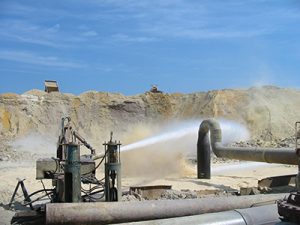
By Mike Fuljenz

The phrase “Peak Gold” has been popping up more frequently. We have been reporting on estimates from various gold mining firms that they have been having trouble finding new deposits of gold, but now we have some solid statistical evidence. The annual “Gold Discoveries” report from S&P Global Market Intelligence confirms that exploration for gold is at historically high levels, but these costly efforts are not producing any significant new gold discoveries. According to S&P’s report, only 215 million ounces of gold have been defined in 41 discoveries over the latest 10 years vs. 1,726 million ounces, eight times as much gold, in 222 discoveries in the preceding 18 years. This does not mean the world is running out of gold, but it does mean that the “easy pickings” have all been found and that the supply of new gold from the ground will gradually decline, even while global gold demand and global affluence is rapidly expanding.
Ian Telfer, chairman of Goldcorp, one of the world’s biggest gold producers, told The Financial Post: “If I could give one sentence about the gold mining business … it’s that in my life, gold produced from mines has gone up pretty steadily for 40 years,” but, he added, “we’re right at peak gold here.” At one point, he said that “we found it all,” meaning we’ve found all the major gold fields, such as the South African Witwatersrand Basin, Nevada’s Carlin Trend, and Australia’s Super Pit, which are all nearing the end of their lives. As a result, Telfer predicts that gold will likely break through $1,500 or, maybe, $1,600 this year.
Other major mining executives have echoed the words of Telfer:
Kevin Dushnisky, president of Barrick Gold, said: “Falling grades and production levels, a lack of new discoveries, and extended project development timelines are bullish for the medium and long-term gold price outlook.”
Vitaly Nesis, CEO of Polymetal: “The fourth quarter last year was in my opinion the peak quarter for fresh global mine supply … I think supply will drop by 15% to 20% over the next three to four years.”
Nick Holland, chief executive of Gold Fields: “We were all talking about how production was going to increase every year. I think those days are probably gone …”
 Here’s another way to look at it. In the 1970s, 1980s, and 1990s, the mining industry found at least one 50+ million-ounce gold deposit, at least ten 30+ million-ounce deposits, and countless 5- to 10-million-ounce deposits each decade. But since the year 2000, the industry has found no 50-million-ounce deposit or even a 30-million-ounce deposit, and very few 15-million-ounce deposits. The grades are also lower.
Here’s another way to look at it. In the 1970s, 1980s, and 1990s, the mining industry found at least one 50+ million-ounce gold deposit, at least ten 30+ million-ounce deposits, and countless 5- to 10-million-ounce deposits each decade. But since the year 2000, the industry has found no 50-million-ounce deposit or even a 30-million-ounce deposit, and very few 15-million-ounce deposits. The grades are also lower.
The idea of “peak gold” doesn’t mean there is no more gold to be found. It means the “low-hanging fruit” has all been picked. There is no equivalent process to “fracking” (for oil) to bring out more gold from the ground. At the same time, there are tougher environmental regulations and more activist governments limiting the miners from destroying the landscape.
Investors with a long-term time horizon need to pay attention to the fundamentals of supply and demand. With a world of 7.3 billion people, including 4.5 billion Asians becoming rapidly wealthier, the demand for gold will constantly increase, while the newly mined supply will peak and then fall. With the global population and per capital GDP growing faster than the new gold supply, the inevitable direction for the price of humanity’s universal currency can only go up.
Mike Fuljenz, president of Universal Coin & Bullion in Beaumont, Texas, is a leading coin expert and market analyst whose insightful writing and consumer advocacy have earned major honors from the ANA, PNG, NLG, and the Press Club of Southeast Texas. His website is www.universalcoin.com.
Want to receive COINage magazine in your mailbox or inbox? Subscribe today!













